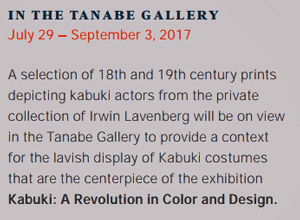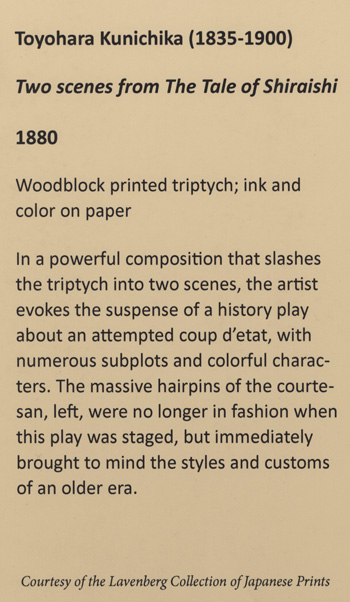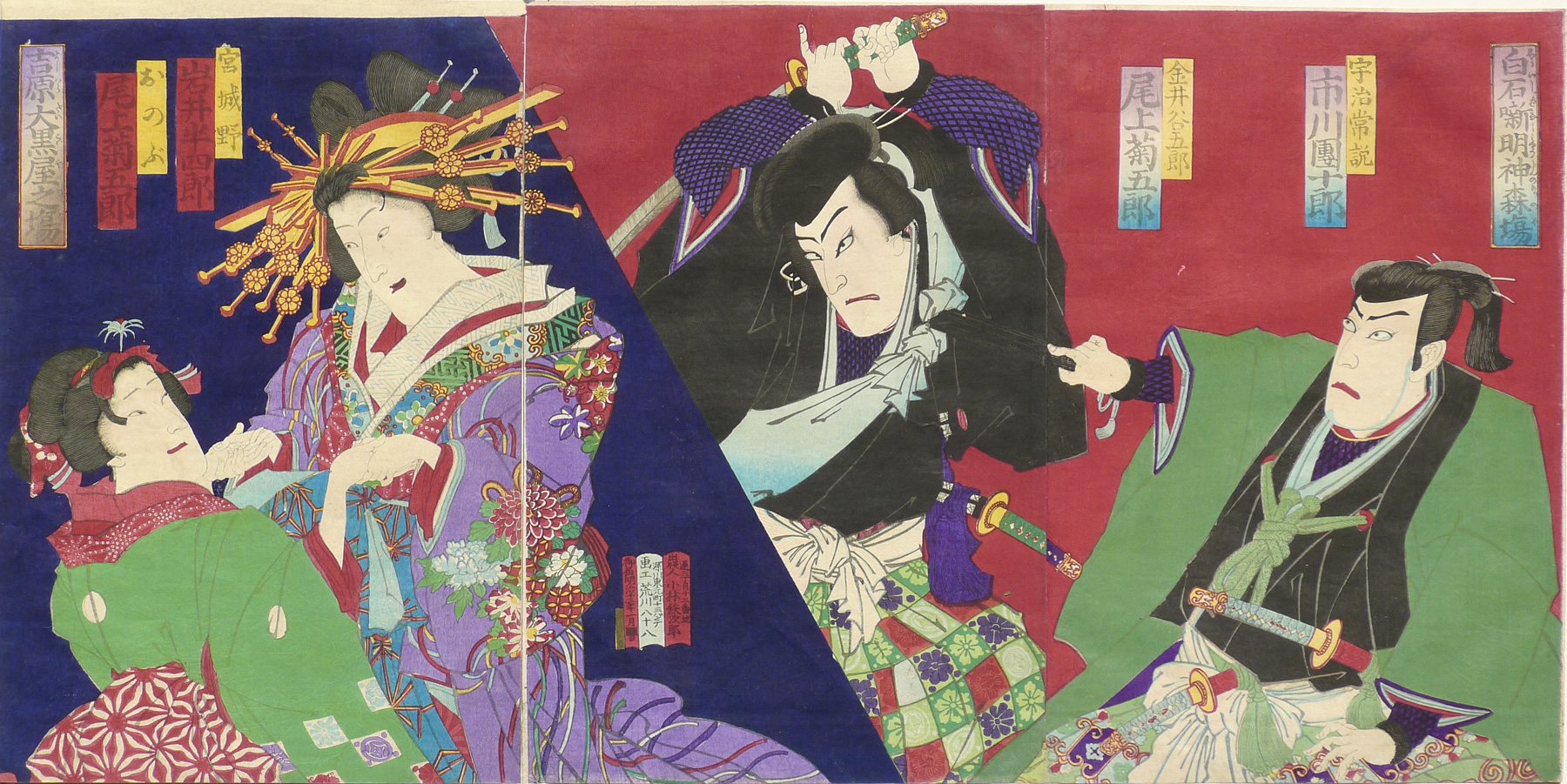About This Print
Picturing two scenes from the play Go Taiheiki Shiraishi Banashi (The Tale of Shiraishi, a Latter-day Taiheiki) - The Forest of the Myojin Shrine (Myōjin mori 明神森) on the right and Yoshiwara Daikokuya Scene (Yoshiwara Daikokuya no ba 吉原大黒屋之場) on the left.The Forest of the Myojin Shrine - on the right Ichikawa Danjūrō IX 市川 団十郎 IX as Uji Jōsetsu 宇治 常説 and to his left with the raised sword Onoe Kikugorō V 尾上菊 五郎 as Kanai Tanigorō 金井 谷五郎.
Yoshiwara Daikokuya - on the right Iwai Hanshirō VIII 岩井半四郎 as the famous Oiran Miyagino 宮城野 and next to her Onoe Kikugorō, once again, playing Onobu おのぶ.
Caught in the Act: Woodblock Kabuki Prints from the Lavenberg Collection of Japanese PrintsJuly 29 - September 3, 2017 in the Tanabe Gallery at the Portland Japanese Garden


Over-the-top stage performances have captivated audiences of kabuki since its inception in the early 1600s - but the role of immortalizing those theatrical moments has long been played by woodblock prints. The print in this exhibition are from the private collection of Irwin Lavenberg. They illustrate the vibrant style of ukiyo-e, pictures of the floating world, which brought colorful images of the stage and demimonde into the hands of an eager public with the rise of Japan's urban culture in the 17th century.
Unlike fine art, woodblock printmaking was a commercial enterprise. Publishers, who were the businessmen behind the production process, rushed to sell print of the latest theatrical sensation to eager kabuki fans. It was the publishers who commissioned artists to design the graphics, which workshops of carvers chiseled into planks of cherry wood, a different one for each color.
Woodblock prints changed as fashions and production evolved over the years. The prints on view here date to the Meiji Period (1868-1912), after Edo had become Tokyo, when Japan was modernizing rapidly. 
New technology introduced from the West meant the introduction of brilliant colors derived from synthetic dyes that smacked of evolving times. Even so, traditions in kabuki print design remained: details masterfully rendered; cartouches giving the actor's name and role; the action unfolding across multiple sheets of paper.
Historical epics, famous romances, thrilling tales of the occult, and swashbuckling heroes kept the theaters booming and kept the woodblock print industry thriving. The success of kabuki is inexorably linked to its portrayal in prints, one lending intensity to the other and delivering to viewers even now the dynamic jolt of stories powerfully told.Courtesy of The Lavenberg Collection of Japanese Prints.Many thanks to Irwin Lavenberg and print specialist, Lynn Katsumoto.

 Over-the-top stage performances have captivated audiences of kabuki since its inception in the early 1600s - but the role of immortalizing those theatrical moments has long been played by woodblock prints. The print in this exhibition are from the private collection of Irwin Lavenberg. They illustrate the vibrant style of ukiyo-e, pictures of the floating world, which brought colorful images of the stage and demimonde into the hands of an eager public with the rise of Japan's urban culture in the 17th century. Unlike fine art, woodblock printmaking was a commercial enterprise. Publishers, who were the businessmen behind the production process, rushed to sell print of the latest theatrical sensation to eager kabuki fans. It was the publishers who commissioned artists to design the graphics, which workshops of carvers chiseled into planks of cherry wood, a different one for each color. Woodblock prints changed as fashions and production evolved over the years. The prints on view here date to the Meiji Period (1868-1912), after Edo had become Tokyo, when Japan was modernizing rapidly. |  |
The Actors Pictured
For background on the actors pictured see their respective entries in the article The Kabuki Actor on this site.The Plot of the Play - Yoshiwara Daikokuya Scene
Source: Kabuki Encyclopedia, An English-Language Adaption of Kabuki Jiten, Samuel L. Leiter, Greenwood Press, 1979. p. 100-101 and The Kabuki Handbook, Aubrey S. & Giovanna M. Halford, Charles E. Tuttle Company, 12th printing 1981, p. 41-46 and as footnoted.
Written for the puppet theater in 1780 by Kino Jōtarō, Utei Enba and Yō Yodai and adapted for kabuki in the same year, the plays "combines the true stories of the attempted coup d'etat of Yui Shōsetsu in 1651 and that of a revenge carried out by two young sisters in the inner provinces in 1717."
In the Yoshiwara Daikokiya scene Onobu and her courtesan sister, Miyagino of the Daikokuya in Shin Yoshiwara, vow to avenge their father's murderer, a village magistrate named Daishichi Shiga, whose villainy also caused their mother to die from grief. The brothel proprietor, Soroku, urges them to learn martial arts from Uji Jōsetsu (the theatrical stand-in for Yui Shōsetsu). Onobu studies fencing and changes her name to Shinobu. Aided by Jôsetsu, the sisters exact their revenge.1
1 the website of http://www.osakaprints.com/content/artists/info_pp/hokushu_info/hokushu_37-a.htm
Print Details
| IHL Catalog | #663 |
| Title (Description) | Shiraishi hanashi (banashi), myōjin mori ba 白石 噺明神森場 (right-most cartouche) and Yoshiwara Daikokuya no ba 吉原 大黒屋 之 場 (left-most cartouche) Two scenes from The Tale of Shiraishi |
| Artist | Toyohara Kunichika (1835–1900) |
| Signature | artist (画工) Arakawa Yasohachi 荒川八十八 as shown in yellow cartouche next to publisher's seal (see Publisher below) |
| Seal | no seal |
| Publication Date |  |
| Publisher |  Kobayashi Tetsujirō 小林 鉄 次 郎 Address: Nihonbashi-dori Sanchome 13-banchi (yellow cartouche contains artist's name and address - see Signature above for details) |
| Carver |  |
| Impression | excellent |
| Colors | excellent |
| Condition | good - light backing; right and center sheets joined; minor trimming |
| Genre | ukiyo-e; yakusha-e |
| Miscellaneous | |
| Format | vertical oban triptych |
| H x W Paper | 14 x 9 3/8 in. (35.6 x 23.8 cm) each sheet |
| Literature | |
| Collections This Print |


